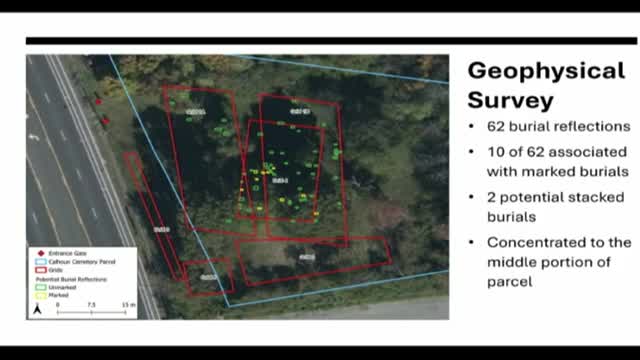Ground-penetrating radar reveals burial sites at Calhoun Cemetery in Nashville
April 21, 2025 | Misc. Metro Meetings and Events, Nashville, Davidson County, Tennessee
Thanks to Scribe from Workplace AI , all articles about Tennessee are free for you to enjoy throughout 2025!

This article was created by AI using a video recording of the meeting. It summarizes the key points discussed, but for full details and context, please refer to the video of the full meeting. Link to Full Meeting
The survey revealed a concentration of burial features in specific grids, notably grid 4, where a high density of marked burials was identified. The data indicated that many of these features were associated with notable individuals, including members of the Pratt family. The findings highlighted the importance of distinguishing between burial sites and other features, such as tree roots, which can complicate interpretations of the data.
One of the key concerns raised was the potential disturbance of burial markers, particularly in areas affected by nearby construction and encampments. The survey noted that a marker for Lizzie Pratt Petway had been disturbed during grading work, raising questions about the integrity of the burial site. Despite extensive GPR surveys, no additional burial features were detected in that area, suggesting that the marker may have been moved or that the burial was not conducted in a way that could be detected by the radar.
To address these preservation challenges, the commission discussed recommendations for protecting the burial sites. Suggestions included installing fencing around known marked burials to deter encampments and marking unmarked burial locations with temporary wooden stakes. A total of 52 unmarked burial sites were identified and marked during the survey, with plans for more permanent low-profile markers to be installed in the future. These markers would be inscribed with relevant information and designed to withstand maintenance activities like mowing.
The meeting underscored the collaborative efforts of various organizations, including the Preservation Society of Nashville and the Nashville Historical Foundation, which provided funding for the project. The commission expressed gratitude for the support that made this crucial work possible, emphasizing the importance of preserving Nashville's historical and cultural heritage for future generations.
Converted from 04/21/2025 Metropolitan Historical Commission meeting on April 21, 2025
Link to Full Meeting
Comments
View full meeting
This article is based on a recent meeting—watch the full video and explore the complete transcript for deeper insights into the discussion.
View full meeting